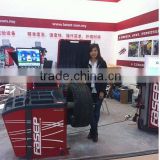car repair shop equipments
Negotiable /Unit
Min.Order:1 Unit
Quick Details View All >
LATEST AUTOMOTIVE TECHNOLOGY SDN. BHD.
V2.13 FW V7.003 KTM100 KTAG ECU Programming Tool Master Version with Unlimited Token
2016 Latest X-PROG M V5.60 ECU Programmer newest version x-prog5.6
2016 New Released X-PROG-M 5.60 X-PROG BOX ECU Chip Programmer best quality Xprog V5.60
2016 Latest Version X-PROG V5.60 ECU Programmer XPROG-M with USB Dongle
Product Details
How to start a car repair business
1. Determine the scope of your business. Some mechanics specialize in particular types of automobile repair. Consider whether or not you wish to limit your business to what you're most skilled at or prefer to open it up to all types of repair. For instance, some repair businesses specialize only in transmission work or engine rebuilds. Some shops do only oil changes and basic tune-ups. Other shops work exclusively on exhaust issues or brake systems. However, many individual mechanics who own their own businesses choose to work on all types of issues.
2. Write a business plan that not only includes the scope and direction of your business, but also provides detailed information about financing, number of employees, planned operating hours, plans for supply/parts ordering and any other details that show your garage will be a viable business. If you are having trouble with this step, a representative from your local Small Business Administration will be able to help you write a business plan.
3. Find a suitable location for your car repair business. If you already have a garage set up that suits your initial purposes for start up, don't relocate your business. However, if you location doesn't suit your needs in size, drive-by traffic counts or any other aspects, consider moving to a new spot. Your new location should be accessible for customers, provide a waiting area and a restroom they may use, and have enough room for you to work and store your tools.
4. Organize your garage to fit your needs. Create proper storage for your tools and supplies, along with an organized parts room for spare parts. If you need additional tools or new equipment for your new business to function efficiently and effectively, purchase them. Be mindful of your budget and do not exceed it with extravagant and unnecessary items.
5. Establish an office for your business. Set it up so that you can keep detailed records about customers, jobs and billing. Keep in mind that not only do you need a functional accounts receivable bookkeeping system, but you also have to have a reliable accounts payable system. Purchase accounting software, a computer, telephones, filing cabinets and other office tools that will help you keep things organized. In addition to setting up your office, take care of some administrative duties by registering with the state as a business and acquire a city business license, if your business is within the city limits.
6. Market your business. Create a flyer with your business name, address and contact information. Hang the flyer up around town on free bulletin boards, hand it out at a parade and distribute it as in insert with your newspaper or local free shopper, if your budget allows. Advertise on the radio and in the newspaper. One cost-efficient way to advertise is to buy an ad in the classified section. Join the local chamber of commerce. Typically, as a new member, you will receive a free ribbon cutting event as a benefit. Often, pictures of ribbon cuttings make it to the newspaper, which gets your business name out there even more.
7. Stay current on auto repair. As new makes and models of vehicles come out every year, the technology for them increases more and more. If you stay up to date by attending workshops and reading material about the new technology, you help to ensure you are able to work on new vehicles, as well as older ones
Contact Supplier

You May Like





New Products
Popular Searches
Recommended Products
Find Similar Products By Category